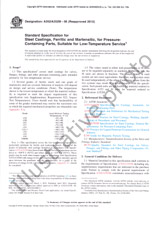We need your consent to use the individual data so that you can see information about your interests, among other things. Click "OK" to give your consent.
ASTM D8488-22
Standard Test Method for Determination of Hydrogen Sulfide (H2S) in Natural Gas by Tunable Diode Laser Spectroscopy (TDLAS)
Translate name
STANDARD published on 1.11.2022
The information about the standard:
Designation standards: ASTM D8488-22
Publication date standards: 1.11.2022
SKU: NS-1090593
The number of pages: 7
Approximate weight : 21 g (0.05 lbs)
Country: American technical standard
Category: Technical standards ASTM
Annotation of standard text ASTM D8488-22 :
Keywords:
hydrogen sulfide, H2S, natural gas, TDL, TDLAS, tunable diode laser absorption spectroscopy,
Additional information
| Significance and Use |
|
5.1?H2S measurements in natural gas are performed to ensure concentrations satisfy gas purchase contract criteria and to prevent pipeline and associated component corrosion. 5.2?Using TDLAS for the measurement of H5.3?Primary applications covered in this test method are listed in 5.3.1 and 5.3.2. Each application may have differing requirements and methods for gas sampling. Additionally, different natural gas applications may require unique spectroscopic considerations. 5.3.1?Raw natural gas is found in production, gathering sites, and inlets to gas-processing plants characterized by potentially high levels of water (H2O), carbon dioxide (CO5.3.2?High-quality sales gas is found in transportation pipelines, natural gas distribution (utilities), and natural gas power plant inlets. The gas is characterized by a very high percentage of methane (90 to 100 %) with small quantities of other hydrocarbons and trace levels of contaminants. |
| 1. Scope |
|
1.1?This test method is for the online determination of hydrogen sulfide (H1.2?UnitsThe values stated in SI units are to be regarded as the standard. No other units of measurement are included in this standard. TDLAS analyzers inherently output concentrations in unitless molar ratios such as ppm(v). Note 1:?Weight-per-volume units such as milligrams or grains
of H1.3?This standard does not purport to
address all of the safety concerns, if any, associated with its
use. It is the responsibility of the user of this standard to
establish appropriate safety, health, and environmental practices
and determine the applicability of regulatory limitations prior to
use.
1.4?This international standard was developed in accordance with internationally recognized principles on standardization established in the Decision on Principles for the Development of International Standards, Guides and Recommendations issued by the World Trade Organization Technical Barriers to Trade (TBT) Committee. |
We recommend:
Technical standards updating
Do you want to make sure you use only the valid technical standards?
We can offer you a solution which will provide you a monthly overview concerning the updating of standards which you use.
Would you like to know more? Look at this page.




 Cookies
Cookies
